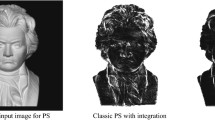Abstract
Stereo rectification is the determination of two image transformations (or homographies) that map corresponding points on the two images, projections of the same point in the 3D space, onto the same horizontal line in the transformed images. Rectification is used to simplify the subsequent stereo correspondence problem and speeding up the matching process. Rectifying transformations, in general, introduce perspective distortion on the obtained images, which shall be minimised to improve the accuracy of the following algorithm dealing with the stereo correspondence problem. The search for the optimal transformations is usually carried out relying on numerical optimisation. This work proposes a closed-form solution for the rectifying homographies that minimise perspective distortion. The experimental comparison confirms its capability to solve the convergence issues of the previous formulation. Its Python implementation is provided.
Access this chapter
Tax calculation will be finalised at checkout
Purchases are for personal use only
Similar content being viewed by others
Notes
- 1.
It can be shown that approaching the roots of the denominator of the distortion function both from the upper and lower limit, the function always goes to \(+\infty \), therefore the global minimum never reaches \(-\infty \), as in Fig. 3.
References
Abraham, S., Förstner, W.: Fish-eye-stereo calibration and epipolar rectification. ISPRS J. Photogramm. Remote. Sens. 59(5), 278–288 (2005)
Besl, P.J.: Active optical range imaging sensors. In: Sanz, J.L.C. (ed.) Advances in Machine Vision, pp. 1–63. Springer, New York (1989). https://doi.org/10.1007/978-1-4612-4532-2_1
Chen, Z., Wu, C., Tsui, H.T.: A new image rectification algorithm. Pattern Recogn. Lett. 24(1–3), 251–260 (2003)
Deriche, R., Zhang, Z., Luong, Q.-T., Faugeras, O.: Robust recovery of the epipolar geometry for an uncalibrated stereo rig. In: Eklundh, J.-O. (ed.) ECCV 1994. LNCS, vol. 800, pp. 567–576. Springer, Heidelberg (1994). https://doi.org/10.1007/3-540-57956-7_64
Fusiello, A., Trucco, E., Verri, A.: A compact algorithm for rectification of stereo pairs. Mach. Vis. Appl. 12(1), 16–22 (2000)
Gallier, J.: Basics of projective geometry. In: Gallier, J. (ed.) Geometric Methods and Applications, pp. 103–175. Springer, New York (2011). https://doi.org/10.1007/978-1-4419-9961-0_5
Gluckman, J., Nayar, S.K.: Rectifying transformations that minimize resampling effects. In: Proceedings of the 2001 IEEE Computer Society Conference on Computer Vision and Pattern Recognition, CVPR 2001 (2001)
Hartley, R., Zisserman, A.: Multiple View Geometry in Computer Vision, 2nd edn. Cambridge University Press, Cambridge (2003)
Hinzmann, T., Schönberger, J.L., Pollefeys, M., Siegwart, R.: Map** on the fly: real-time 3d dense reconstruction, digital surface map and incremental orthomosaic generation for unmanned aerial vehicles. In: Hutter, M., Siegwart, R. (eds.) Field and Service Robotics. SPAR, vol. 5, pp. 383–396. Springer, Cham (2018). https://doi.org/10.1007/978-3-319-67361-5_25
Hornberg, A.: Handbook of Machine and Computer Vision: The Guide for Developers and Users. Wiley, Weinheim (2017)
Kumar, S., Micheloni, C., Piciarelli, C., Foresti, G.L.: Stereo rectification of uncalibrated and heterogeneous images. Pattern Recogn. Lett. 31(11), 1445–1452 (2010)
Loop, C., Zhang, Z.: Computing rectifying homographies for stereo vision. In: 1999 IEEE Computer Society Conference on Computer Vision and Pattern Recognition, vol. 1 (1999)
Lu, H., Plataniotis, K., Venetsanopoulos, A.N.: Multilinear Subspace Learning: Dimensionality Reduction of Multidimensional Data. Chapman & Hall/CRC (January 2013)
Luong, Q.-T., Faugeras, O.D.: The fundamental matrix: theory, algorithms, and stability analysis. Int. J. Comput. Vis. 17(1), 43–75 (1996)
Monasse, P., Morel, J.-M., Tang, Z.: Three-step image rectification. In: BMVC 2010-British Machine Vision Conference (2010)
**ao, R., Sun, W., Pang, J., Yan, Q., Ren, J.: DSR: direct self-rectification for uncalibrated dual-lens cameras. In: International Conference on 3D Vision (2018)
Liansheng, S., Jiulong, Z., Duwu, C.: Image rectification using affine epipolar geometric constraint (2009)
Sun, C.: Closed-form stereo image rectification. Association for Computing Machinery (2012)
Turrini, C.: Geometria per la ricostruzione tridimensionale (2017)
**a, R., et al.: An accurate and robust method for the measurement of circular holes based on binocular vision. Measure. Sci. Technol. 31(2), 025006 (2019)
Yin, X., Wang, X., Yu, J., Zhang, M., Fua, P., Tao, D.: FishEyeRecNet: a multi-context collaborative deep network for fisheye image rectification. In: Ferrari, V., Hebert, M., Sminchisescu, C., Weiss, Y. (eds.) ECCV 2018. LNCS, vol. 11214, pp. 475–490. Springer, Cham (2018). https://doi.org/10.1007/978-3-030-01249-6_29
Zhang, Z.: A flexible new technique for camera calibration. IEEE Trans. Pattern Anal. Mach. Intell. 22(11), 1330–1334 (2000)
Xue, Z., Xue, N., **a, G.-S., Shen, W.: Learning to calibrate straight lines for fisheye image rectification (April 2019)
Author information
Authors and Affiliations
Corresponding author
Editor information
Editors and Affiliations
Appendix A
Appendix A
The coefficients of the \(4^{th}\) order polynomial expression in \(y_1\) of Eq. (38) are:
with:
The four roots of the equation are given by:
with:
Remark: for the case \(\mathbf {A}_1 = \mathbf {A}_2\), \(\mathbf {P}_1 = \mathbf {P}_2\), \(\mathbf {P}_{c1} = \mathbf {P}_{c2}\) and \(\mathbf {R}_1 = \mathbf {R}_2\), the solution is given by:
Rights and permissions
Copyright information
© 2022 The Author(s), under exclusive license to Springer Nature Switzerland AG
About this paper
Cite this paper
Lafiosca, P., Ceccaroni, M. (2022). Rectifying Homographies for Stereo Vision: Analytical Solution for Minimal Distortion. In: Arai, K. (eds) Intelligent Computing. SAI 2022. Lecture Notes in Networks and Systems, vol 507. Springer, Cham. https://doi.org/10.1007/978-3-031-10464-0_33
Download citation
DOI: https://doi.org/10.1007/978-3-031-10464-0_33
Published:
Publisher Name: Springer, Cham
Print ISBN: 978-3-031-10463-3
Online ISBN: 978-3-031-10464-0
eBook Packages: Intelligent Technologies and RoboticsIntelligent Technologies and Robotics (R0)




